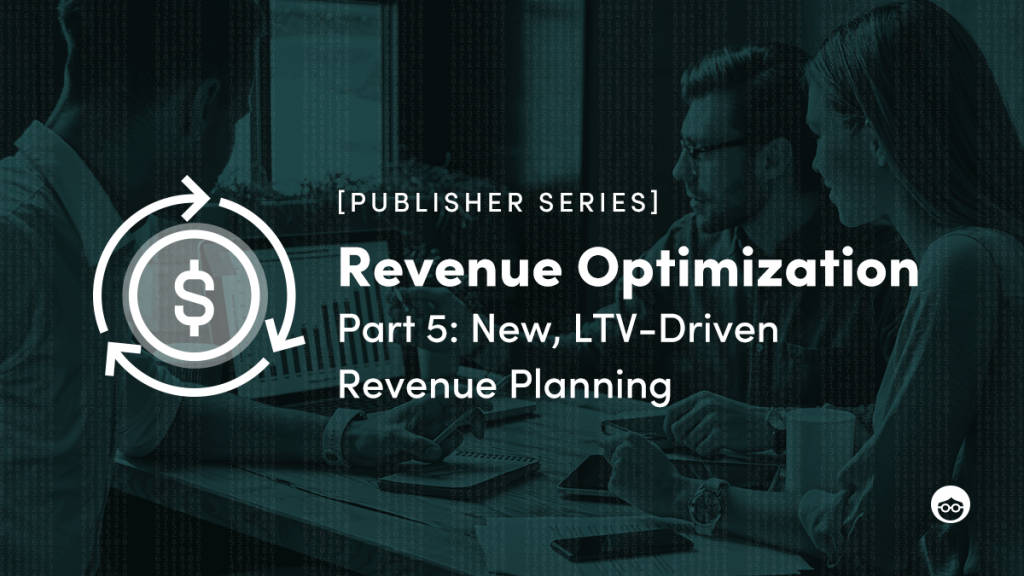[Publisher Series] Revenue Optimization, Part V: New, LTV-Driven Revenue Planning

While 2020 has definitely been a year of quick decision-making and program pivoting — as new unknowns present themselves each and every day — your long-term strategy planning shouldn’t be deterred. Even if it seems temporarily difficult to wrap your head around the future, the “new normal” we continue experiencing will become just that — normal.
That all said, do you feel as though you have a winning, forward-looking strategy?
Throughout this Revenue Optimization Series, we’ve delved into four main pillars to maximizing publisher revenue:
- Reporting, Data, and Insights: Establishing your data framework to test and optimize.
- Existing Revenue Sources + RPMs: Getting the highest, most effective RPMs.
- Existing Page Layouts: Increasing impressions and revenue per session.
- Traffic Sources: Leveraging traffic acquisition tactics to drive new and repeat users.
Now that we have this base of revenue optimization, we must look ahead to what’s next.
From personal experience — no matter what hecticness may be going on in the world — I continue to create a ten-year vision and five-year plan. Even if I never reach either, this gives me a guiding lighthouse of where I’m headed and what decisions to make to help me get there.
With you — publishers — having accepted your latest reality, let’s take a look at the industry at large, your own specific experiences, and create a new long-term strategy.
Start With Your Ending — Predict the Future
Yes, you read that correctly — believing in the power of visualization, it’s important to have a hypothesis for where the industry is headed over the next five to ten years.
Start by making a list of growing trends that are already impacting your business. For example, digital video engagement — CTV, or Connected TV, continues to proliferate outside of linear television, generating larger advertising dollars for all players involved. These dollars should continue to grow over the next few years with the rollout of faster bandwidth, more distributed live environments, and increased video consumption.
That merely skims the surface. There are plenty of other factors that will impact our industry, including data privacy, header bidding, and continued consolidation. And to make sure you don’t miss any blind spots, these exercises should be done with Executives and key personnel from different departments.
For each major trend list, be sure to include the implications for your company, the content produced, user behavior, competition, and other helpful details. Further, ask yourself and your working group the difficult questions, such as (but certainly not limited to!);
- How are users responding to instream ads?
- How has video affected consumer buying or consumption habits?
- Could we envision video advertising driving performance campaigns?
Once you have a good list of future drivers and their dependencies, for each scenario, assign a probability and select the top two or three most likely outcomes.
From there, you can begin to map out a strategy.
Many frameworks can aid with decision-making, though below are two that can help determine which may be most appropriate. The first helps identify paths to scale beyond the current state and the second helps determine which option to choose if you have more than one viable alternative.
Framework #1: Expansion Opportunities
Before we jump in, do note that expansion is not necessarily growth — companies can grow organically without expanding beyond their existing products or customers. And as we covered in previous segments, expansion strategies not only help a company grow, but also minimize risk through diversification.
One of my favorite frameworks to help identify expansion opportunities is a simple two-by-two grid, as shown below.
First, start with the top left quadrant — this is the current state of your business, containing existing users, products, and paying clients.
Next, you want to envision various ways to expand your business. Below you’ll find sample bullet points for a fictional publisher to help make this exercise a little easier to follow. It’s important to note that there’s no specific route you have to take first — could be Existing Users/Product to New Clients in Expansion #2 or Existing Users/Products to New Users/Products in Expansion #1. So long as you’re expanding, that is!
Expansion Considerations
Expansion #1; Here, you’ll want to consider additional options to sell to existing clients. For example, if Brand Advertisers are your core clients, ask yourself what else you can sell them. New audiences? Lower-funnel conversions? eCommerce?
To minimize bias risk, be sure to ask your clients what else you can offer them that they’d value and pay for. All are viable options that will require investment, so ensure the added value each could generate is estimated.
Expansion #2; Here, we keep users, products, and content constant. Instead, we consider what other clients — including revenue models, as changing to a Subscription model could take your users to clients, for example. Of course, this may require retaining Sales Teams and creating new Product and Marketing materials.
Expansion #3; This expansion can truly only be successful after proper implementations of Expansion #1 or #2 — perhaps outside of Acquisition.
So, if the first step of expansion takes three to five years, and the second jump another three to five years, you’ve just mapped out a ten-year expansion plan.
Now, let’s choose one path, assuming this exercise generates a couple of viable opportunities for you.
Framework #2: Decision Tree
The best way to tackle almost any decision is by utilizing the Decision Tree, pictured below.
We’ve already brainstormed possible industry outcomes and decided which paths your company can pursue for expansion. Now, it’s time to figure out which of these paths is the best option given possible future outcomes.
The first decision being whether or not to proceed first with Expansion #1 or Expansion #2. For each possibility, calculate the investment and timeline required to execute. Then, calculate the projected revenue or value given a set of potential outcomes and their respective probabilities.
By quantifying costs, returns, and probability for each scenario, you’ll then be able to compare the net value of each to more easily select the winning strategy.
In the example above, Expansion #1’s High Demand scenario assumed $16M at 30% probability or a Medium Demand scenario of $10M at 50%. Combined, that’s a $9.8M (call it $10M) value from a $6M investment. On the other side, Expansion #2 could generate $10M with a 40% probability or $7M with a 60% probability for a combined $8.2 (call it $8M) value. So here, we’d choose Expansion #1 as the path forward.
You can keep expanding the Decision Tree as needed. For example, as you’re trying to value the gains from Expansion #1 under High Demand, you may need further Product or R&D development that requires a second investment. In that case, simply create another decision triangle, contemplating the impacts if you either invest further or don’t invest.
Decision Trees are a great way to quantify decisions given a set of possible scenarios. Remember to write down all assumptions to be able to revisit them at a later date. This way, you can see how they measure up against your realities.
After seeing out these exercises, you should have a more detailed, quantitative, strategic direction to pursue for the next few years.
Winding Down — One Last Time
The last seven months have been difficult, if not heartbreaking, for many.
Those that previously had a well-established strategy, diversified revenue, optimized sites, and proper data to guide them during this critical time didn’t experience as much of a hit — rebounding decently during the upturn. As a result, they quickly recovered and are now doing as well as, or better than, last year.
Our genuine hope over this five-part Revenue Optimization Series wass to get you, our Publisher partners, thinking about your strategies and decisions in a quantifiable manner. And if you had one “a-ha” moment, one insight, or one suggestion — then we’ll be extremely happy to hear it. Feel free to comment below or share this article — any feedback gained will only help us better our future articles, and further, support for our Publishers.
Huge thank you to everyone who contributed to the series — we’re extremely humbled by the strength of our partnerships, and the respect and congeniality shared by our colleagues. Wishing everyone a healthy and prosperous rest of the year.
All five parts of our five-part series are live and available for you below.
- Live — Part 1: Reporting, Data, and Insights
- Live — Part 2: Optimizing Existing Revenue Sources + RPMs
- Live — Part 3: Optimizing Existing Page Layouts
- Live — Part 4: Optimizing Traffic Sources
- Live — Part 5: New, LTV-Driven Revenue Planning
And don’t forget — you too can discover how you can manage, control, and monetize your site on the Open Web.




